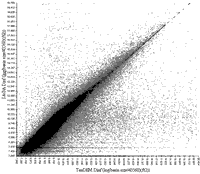 |
 |
 |
 |


Appendix F
|
Programs Used For Flow Direction SAGA – http://geosun1.uni-geog.gwdg.de/saga/ SAGA preformed the D8, Dinf, MFD, and DEMON flow direction algorithms that were tested of this study. The main reasoning in using SAGA was that most programs could not handle a large LiDAR dataset. TAS, TauDEM and at times ArcGIS would fail when attempting to use a 2-m LiDAR DEM. SAGA used a memory cache to process data. In doing this, process time increased significantly in calculating DEMON, Dinf, and MFD flow algorithms. Demon at 2-m grid size took at around a day to compute while MFD and Dinf was half that. D8 only took a few hours. Using 6-m grid cell size, process time for all flow direction algorithms decreased to a few hours. SAGA was verified using ArcGIS for the D8, TauDEM for Dinf and TAS for MFD on a 10-m DEM. DEMON was verified by Dr. Steven Burges. Regression analysis was performed on the flow accumulation outputs from the 10-m DEM by the flow direction types. The only differences were in how the algorithms handled flat terrain. Appendix Figure F1 and Appendix Table F1 is an example of the regression analysis that was done to verify SAGA performed the flow direct algorithms accurately.
|
|||||||||||||||||||||||||||||||||||||||



